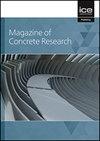Assessment of hybrid effect between polyethylene fiber and nano-calcium carbonate for flowability and strength of geopolymer composite
IF 1.8
4区 工程技术
Q3 CONSTRUCTION & BUILDING TECHNOLOGY
引用次数: 1
Abstract
Using geopolymer composites to reduce the use of Portland cement can decrease carbon dioxide emissions. The focus of this study was on improving the strength of a geopolymer composite by assessing the positive hybrid effect of nano-calcium carbonate (NCC) and polyethylene fibres (PFs) of different lengths (6 mm and 12 mm). Fresh and hardened properties, including flowability and strength, were investigated to evaluate the hybrid effect. Generally, the hybrid effects from the PFs of different lengths and NCC were negative for flowability, but the hybrid effects were positive on strength. The combination of 12 mm PF + 6 mm PF + 1% NCC was found to have the highest hybrid effect on bending strength, resulting from the good fibre–matrix bond. The bending strength of the PF-reinforced geopolymer composite was assessed based on a new regression coefficient (A), which takes into account the hybrid effect, the fibre–matrix bond strength and fibre dispersion. The new model for the bending strength of PF-reinforced geopolymer composites introduced in this paper is simpler and more effective than previous models provided in the literature.聚乙烯纤维与纳米碳酸钙杂化对地聚合物复合材料流动性和强度的影响
使用地聚合物复合材料来减少波特兰水泥的使用可以减少二氧化碳的排放。本研究的重点是通过评估不同长度(6毫米和12毫米)的纳米碳酸钙(NCC)和聚乙烯纤维(PFs)的正杂化效应来提高地聚合物复合材料的强度。研究了混合效果的新鲜和硬化性能,包括流动性和强度。一般来说,不同长度的PFs和NCC的杂化效应对流动性是负的,而对强度是正的。12 mm PF + 6 mm PF + 1% NCC的组合对抗弯强度的混杂效应最高,这是由于良好的纤维基质结合。考虑混杂效应、纤维基质结合强度和纤维分散等因素,采用新的回归系数(a)对pf增强地聚合物复合材料的抗弯强度进行了评价。本文提出的pf增强地聚合物复合材料抗弯强度计算模型比已有的模型更简单、更有效。
本文章由计算机程序翻译,如有差异,请以英文原文为准。
求助全文
约1分钟内获得全文
求助全文
来源期刊

Magazine of Concrete Research
工程技术-材料科学:综合
CiteScore
4.60
自引率
11.10%
发文量
102
审稿时长
5 months
期刊介绍:
For concrete and other cementitious derivatives to be developed further, we need to understand the use of alternative hydraulically active materials used in combination with plain Portland Cement, sustainability and durability issues. Both fundamental and best practice issues need to be addressed.
Magazine of Concrete Research covers every aspect of concrete manufacture and behaviour from performance and evaluation of constituent materials to mix design, testing, durability, structural analysis and composite construction.
 求助内容:
求助内容: 应助结果提醒方式:
应助结果提醒方式:


